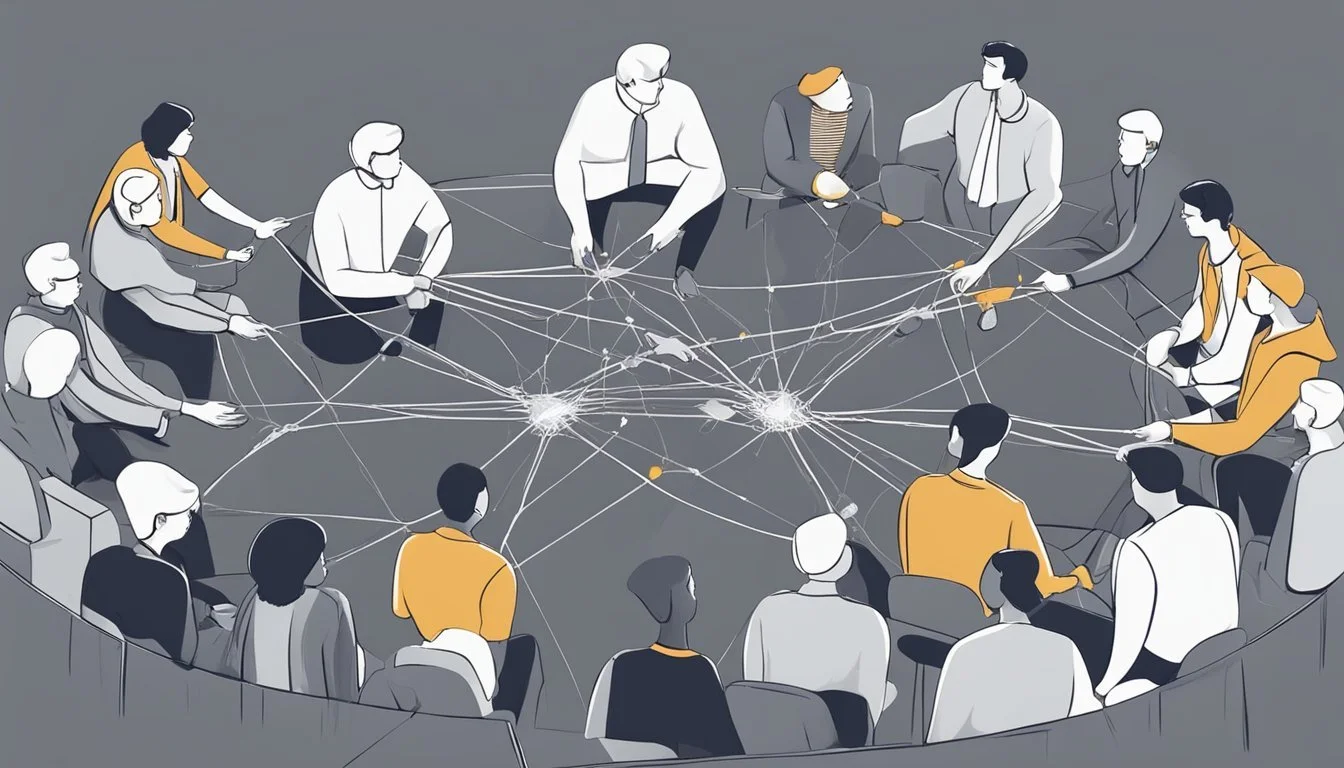9 Common Myths About PTSD in Activists
Debunking Misconceptions
Post-Traumatic Stress Disorder (PTSD) is a serious mental health condition that can affect anyone who has experienced significant trauma, including activists who are often exposed to high-stress environments. Despite the growing awareness of PTSD, numerous myths persist that can hinder understanding and support for those affected.
This article aims to debunk common myths about PTSD in activists and shed light on the realities of living with this condition. By addressing these misconceptions, the goal is to foster a more informed and compassionate perspective, encouraging better mental health support for those dedicated to advocacy and social change.
1) Myth: PTSD is exclusive to combat veterans.
PTSD, or Post-Traumatic Stress Disorder, affects not just combat veterans but anyone who has experienced a significant trauma. This includes activists who may face traumatic events during protests or advocacy work.
Activists often witness violence, police brutality, or suffer harassment. These experiences can lead to PTSD symptoms similar to those seen in combat veterans.
Traumatic events such as arrests, physical assaults, and verbal threats can all trigger PTSD. These stressors can deeply impact an activist's mental health, leading to flashbacks, anxiety, and emotional distress.
Exposing oneself to repeated traumatic events can amplify the risk of developing PTSD. Activists continuously fighting for causes often find themselves in high-stress situations that could result in trauma.
While the image of PTSD is often tied to combat veterans, it is crucial to understand its prevalence in various fields. Recognizing this can help activists seek appropriate mental health support and resources.
For more information on this topic, refer to the myth that PTSD only affects veterans as discussed by Vox.
2) Myth: PTSD sufferers are always violent
There is a common belief that individuals with PTSD are inherently violent. This perception often leads to stigma and discrimination against those suffering from the condition.
Research shows that PTSD does not inherently make a person violent. Many people with PTSD are non-violent and manage to lead productive lives.
It's crucial to recognize that symptoms of PTSD, such as hypervigilance and irritability, are not the same as tendencies toward violence. These symptoms are part of the disorder's complex impact on emotional regulation and coping mechanisms.
Understanding this distinction helps in providing the right support to those affected. Addressing the myth can foster a more compassionate and informed perspective on PTSD. For more information, you can explore common myths about PTSD.
3) Myth: PTSD is a sign of weakness.
PTSD is often mislabeled as a sign of weakness, but this perception is incorrect. PTSD is a diagnosable mental health condition resulting from significant trauma. It is unrelated to personal strength or resilience.
Experiencing trauma can lead to changes in the brain's fear response mechanisms. This can affect cognitive functions like memory, attention, and problem-solving abilities. These changes reflect a physiological response to extreme stress rather than a character flaw.
PTSD can impact anyone who has experienced a traumatic event. It is not limited to combat veterans. Trauma can stem from various sources, including accidents, natural disasters, or personal assaults.
The strength of individuals with PTSD can be seen in their continued efforts to navigate daily life despite the challenges posed by their condition. Resources like therapy and support groups play a crucial role in helping them manage symptoms.
Labeling PTSD as a sign of weakness only stigmatizes those affected and creates obstacles to seeking help. Recognizing PTSD as a serious mental health condition is vital to understanding and supporting those who live with it. For further information, see 8 Common Myths About PTSD.
4) Myth: Therapy doesn't work for PTSD
There is a misconception that therapy is ineffective for PTSD. This is not true. Various forms of therapy, including Cognitive Behavioral Therapy (CBT) and Eye Movement Desensitization and Reprocessing (EMDR), have proven beneficial for treating PTSD. Research supports that these therapies help individuals process and manage trauma.
People often believe only medication can address PTSD symptoms.
Therapists use evidence-based techniques to help patients understand and cope with trauma. Over time, this can significantly reduce PTSD symptoms. Additionally, therapy offers a safe space for individuals to discuss their experiences and emotions.
Some may think therapy is a long and slow process.
While therapy may take time, many individuals begin noticing improvements relatively quickly. Consistent therapy sessions can lead to lasting changes in mental health. Individuals need to stay committed to the process and work closely with their therapists.
For instance, CBT helps change negative thought patterns associated with trauma. EMDR, on the other hand, uses eye movements to process trauma memories differently. Both methods have shown positive outcomes for many PTSD sufferers. Thus, therapy remains a crucial part of PTSD treatment plans.
To learn more about the efficacy of these treatments, refer to 10 Common Myths About PTSD - Emory Healthcare.
5) Myth: Activists with PTSD can't be effective.
It's a common misconception that individuals with PTSD can't perform effectively as activists. This myth is harmful and discounts the resilience and strength that these individuals can bring to advocacy.
Those with PTSD can use their experiences to fuel their activism. They often have a deeper understanding of injustice and trauma, which can drive meaningful change.
Activists with PTSD may also develop strong support networks. These networks can offer both emotional support and practical assistance, enabling activists to continue their important work.
Accommodating mental health needs in activist circles is essential. This might involve creating safe spaces, offering mental health resources, and promoting a culture of understanding and acceptance.
Activists with PTSD can also benefit from their unique perspectives. They can help to educate and inform others about trauma, resilience, and recovery.
It's important to challenge stereotypes about PTSD. Doing so can help to foster more inclusive and supportive activist communities.
Historical and contemporary examples show that many successful activists have overcome personal challenges, including PTSD. Their contributions have been significant and enduring.
By recognizing the capabilities of activists with PTSD, society can harness a wider array of strengths and insights. This acknowledgment fosters a more robust and diverse movement for change.
6) Myth: Only first responders develop PTSD.
Many believe that PTSD is exclusive to first responders, such as firefighters, police officers, and paramedics.
This is not accurate. While these professionals do face high levels of stress and trauma, they are not the only ones at risk.
Anyone who experiences a traumatic event may develop PTSD. This includes activists who may witness violence, experience harassment, or undergo stressful confrontations.
For instance, activists working in high-conflict areas or those exposed to continuous stress can also suffer from PTSD.
Additionally, it's important to understand that trauma is subjective. What is traumatic for one person may not be for another.
Thus, PTSD can develop in various individuals, not just those in emergency services.
Awareness about this can help in providing the necessary support for all affected individuals.
For more information on PTSD myths, refer to the Gateway Foundation.
7) Myth: PTSD is a life sentence.
PTSD is often perceived as a permanent condition. This belief can be discouraging for those afflicted, making them feel trapped by their symptoms. In reality, effective treatments are available that can significantly improve one's quality of life.
Many individuals with PTSD experience relief through therapies such as cognitive-behavioral therapy (CBT) and eye movement desensitization and reprocessing (EMDR). These treatments have been shown to reduce symptoms and help individuals process traumatic events.
Medications can also play a role in managing PTSD. Antidepressants, particularly selective serotonin reuptake inhibitors (SSRIs), are commonly prescribed to help alleviate symptoms. These medications can be effective when used in conjunction with therapy.
Support from family and friends is crucial. Social support can enhance the effectiveness of other treatments and provide a sense of community. Peer support groups also offer a space for sharing experiences and coping strategies.
Recovery from PTSD is possible. It’s important to recognize that while the journey may be challenging, many people do find significant improvement. Research indicates that with proper treatment and support, individuals can lead fulfilling lives. For more information, visit PTSD Myths or Myths of Posttraumatic Stress Disorder.
8) Myth: Medications are the only treatment.
Medications are one option for treating PTSD, but they are not the only method. Psychotherapy, often referred to as talk therapy, is a well-established approach. Techniques such as Cognitive Behavioral Therapy (CBT) and Eye Movement Desensitization and Reprocessing (EMDR) are highly effective in managing PTSD symptoms.
Group therapy offers another valuable option. Connecting with others who have similar experiences can provide significant emotional relief and support. Many people find that group sessions help them feel understood and less isolated.
Lifestyle changes also play a crucial role in managing PTSD. Exercise, adequate sleep, and a healthy diet contribute positively to mental well-being. Mindfulness and meditation practices can reduce stress and improve emotional regulation.
Support from family and friends is equally important. Having a reliable support system can alleviate some of the burdens associated with PTSD. Encouragement from loved ones often motivates individuals to seek and continue treatment.
Holistic therapies such as yoga and acupuncture are also beneficial. These practices can help in reducing anxiety and promoting a sense of calm. Integrating various treatments often results in better outcomes than relying on medications alone.
For more on debunking PTSD myths, visit this resource on PTSD myths.
9) Myth: PTSD always develops immediately after trauma.
PTSD does not always develop immediately following a traumatic event. Symptoms can emerge weeks, months, or even years later. This delay is common and does not diminish the validity of the disorder.
The onset of PTSD can vary greatly among individuals. External factors, such as ongoing stress or additional traumatic experiences, can influence when symptoms appear.
Studies have shown that PTSD symptoms may come and go over time. This ebb and flow can lead to periods of apparent stability followed by intense symptom flare-ups.
People with PTSD may experience different triggers that reignite symptoms long after the initial trauma. These triggers can be subtle and seemingly unrelated to the original event.
There is no standard timeline for PTSD development. Each person's experience with trauma and PTSD is unique, requiring a personalized approach to treatment and support.
To learn more, read about [PTSD myths information](https://www.columbiadoctors.org/health-library/article/ptsd-myths\).
Understanding PTSD in Activists
Activists often face unique stressors and traumas due to their work, which can result in PTSD. This section explores the definition and symptoms of PTSD, and its prevalence among activist groups.
Definition and Symptoms
Post-Traumatic Stress Disorder (PTSD) is a mental health condition triggered by witnessing or experiencing traumatic events. Symptoms specific to activists may include intrusive memories, flashbacks, and severe anxiety.
Other symptoms:
Avoidance: Staying away from places, events, or objects that remind them of the traumatic experience.
Cognitive and mood symptoms: Includes negative thoughts about oneself, distorted feelings of guilt or blame, and loss of interest in activities.
These symptoms can disrupt daily functioning and interpersonal relationships, making it imperative for activists to recognize and seek help for PTSD.
Prevalence Among Activists
Activists are often at the forefront of social and political movements, exposing them to high-risk situations and potential trauma. Studies indicate that a significant proportion of activists may develop PTSD due to their prolonged exposure to violence, harassment, and oppression.
A recent article from Activist Trauma Support highlights the necessity of building resilience within activist communities. Mental health support systems are crucial in addressing the psychological impacts faced by these groups.
Awareness and proper support can empower activists to continue their vital work while managing their mental health effectively.
Common Myths About PTSD in Activists
Activists are no strangers to stressful and traumatic experiences. Despite their strong public personas, they are vulnerable to myths and misunderstandings surrounding PTSD.
Myth 1: Only Veterans Suffer from PTSD
One common misconception is that PTSD is limited to military veterans. PTSD can affect anyone who has experienced trauma.
Activists often face intense stress, threats, and violence. This can lead to PTSD, just like in any other traumatic situation.
The trauma can include physical attacks, online harassment, or witnessing violence. These experiences can profoundly impact mental health.
Myth 2: Activists Are Always Resilient
Another myth is that activists possess inherent resilience against mental health issues. While many activists exhibit strong coping mechanisms, they are still susceptible to PTSD.
Being passionate about a cause does not make one immune to trauma. Continuous exposure to distressing events can take a toll.
Overwork and burnout are also significant risk factors. Activists need proper support and self-care to maintain their mental health.
Myth 3: PTSD Only Occurs Immediately After Trauma
There's a belief that PTSD symptoms appear right after a traumatic event, but this is not always the case.
For some activists, symptoms may emerge months or years later. This delayed onset can lead to confusion and misdiagnosis.
Persistent stress from ongoing activism might exacerbate or trigger latent symptoms. Recognizing these symptoms early is crucial.
Understanding that PTSD can manifest long after the initial trauma helps in providing timely and effective support.
Impact of Myths on Activists' Mental Health
Myths surrounding PTSD can significantly affect activists by exacerbating feelings of isolation and creating barriers to seeking necessary mental health support. These impacts are crucial to understanding how misinformation can hinder the well-being of those committed to social causes.
Stigmatization and Isolation
Activists with PTSD often face stigmatization due to myths suggesting that mental illness equates to weakness or instability. This stigma can lead to a lack of acceptance within activist communities, further isolating individuals already dealing with PTSD.
Furthermore, the myth that mental health disorders make individuals more dangerous unfairly portrays activists suffering from PTSD, creating an environment where they may feel unwelcome or judged. This stigmatization not only affects interpersonal relationships but also erodes the sense of unity and support critically needed in advocacy work.
Barriers to Seeking Help
Myths, such as the belief that PTSD can be overcome solely through willpower or that it only affects certain groups, hinder activists from seeking professional help. This notion can perpetuate the idea that PTSD is a personal failing rather than a legitimate medical condition requiring treatment.
Because of these misconceptions, activists may avoid seeking therapy or other mental health services, fearing that admitting to needing help will be seen as a sign of inadequacy. This self-imposed barrier can delay or prevent access to effective treatments, worsening their condition and impacting their ability to contribute fully to their causes.
Implementing educational initiatives to dispel these myths is essential for creating a supportive environment that encourages mental health support without judgment.







